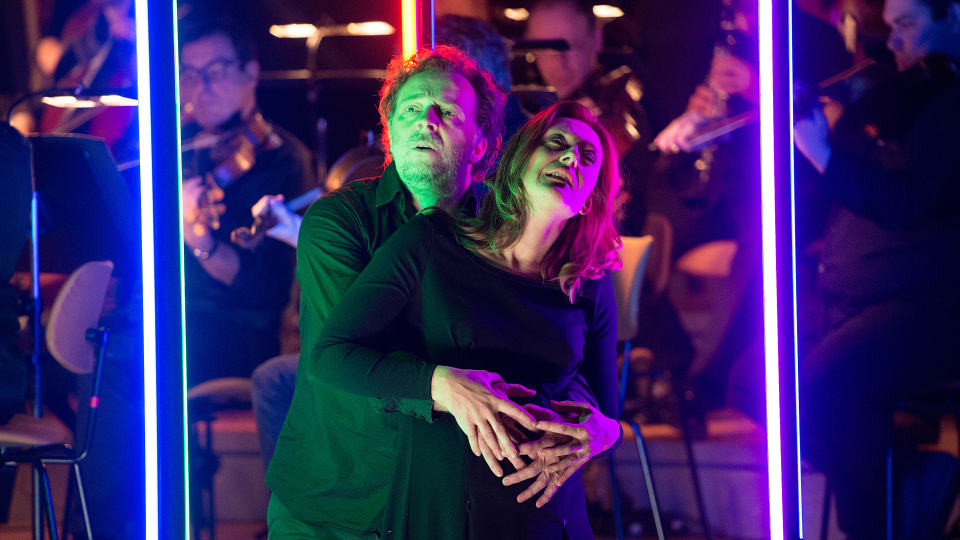Simon Rattle brought Debussy Pelléas et Mélisande to London tonight, at the Barbican Hall instead of the Philharmonie, Berlin, and with the LSO instead of the Berliner Philharmoniker. This new production has been called the Star Wars Pelléas et Mélisande because there are columns of light, like the light sabres. That's not inappropriate since the opera is in a sense a cosmic battle between avatars.
The opera deals with real emotions, like insecurity and jealousy, but the situation is anything but realistic. Who is Mélisande? Why does she go from man to man, repelled by them yet submissive Is she human at all, or a projection of the fantasies of those around her? The emotions this opera deals with are real enough but Allemonde is a dream state rather than reality. What is Allemonde? Is it a kingdom or a state of mind? Yniold is scared of the starving peasants, but why is he out on his own playing with a golden ball? The tower, the pool and the impossibly long hair are all symbols of sexual portent. The contrasts between debiltating heat and suffocating darkness suggest psychological responses to physical states. For all we know, Allemonde is the subconscious, and we are the blind men.
So, in principle, no objection to Pelléas et Mélisande as Star Wars. Peter Sellars' semi-staging was designed around the performing space that is the Philharmonie, making use of the wide wings around the main stage, and using the different levels to depict the unsettling heights and depths in the narrative. Centre stage, Magdalena Kožená and Christian Gerhaher lie on a black plinth which serves as pondside and tower. Gerhaher and Gerald Finley climb an unsteady angle lit in green light when they descend into the caverns beneath the castle. The Philharmonie and the Barbican, however, are very different structures, so the Berlin staging can't really be replicated at the Barbican. The acting can, though it was a problem since it consists mainly of stylized gesture. Close up it bordered on ham acting, which these singers would not otherwise do, since they're all natural stage animals. Maybe Sellars thinks the characters are drugged? Again, in principle, this is fine, reflecting the stylization inherent in the plot, but I didn't like it.
Maybe the idea is to enhance the sense of non-reality so we can focus on the music? Although I haven't listened to my old tapes of Rattle's earlier performances of Pelléas et Mélisande, this time I felt the pace seemed drawn out, as if the languors in the text were affecting the orchestra. Still, the Berliner Philharmoniker doesn't ever play badly, and it was good to listen to the details of colour and light. Those who oppose a world-class concert hall for London need to hear what a difference a really good hall makes. The Barbican just isn't Philharmonie class. Rattle is most certainly not thinking in terms of vanity project but common sense.
When Rattle conducted Pelléas et Mélisande in Berlin ten years ago, with Simon Keenlyside in his prime, the performance was wonderful, much better than at the Royal Opera House. This time around, Gerald Finley sings Golaud as he did before, his voice darker and possibly closer to Golaud's gruff personality. Magdalena Kožená sang Mélisande as she did in Berlin in 2008 and Christian Gerhaher sings Pelléas, somewhat disengaged. Perhaps the roles are supposed to be that way, but a bit more engagement might have livened things up. I don't like the current fashion for Kožená-baiting, reminiscent of the hate campaigns against Callas and Schwarzkopf. She's not in their league but she's not bad. Mélisande sits a little too close to Lulu for her, but she's done amazing Martinu Juliettas. Bernarda Fink sang Geneviève and Franz Josef Selig sang a sprightly Arkel. I bought a ticket to the Barbican when they went on sale last year, but didn't go at the last moment. Much as I love the LSO and the Barbican, I want to remember the Philharmonie and the Berliner Philharmoniker.

No comments:
Post a Comment